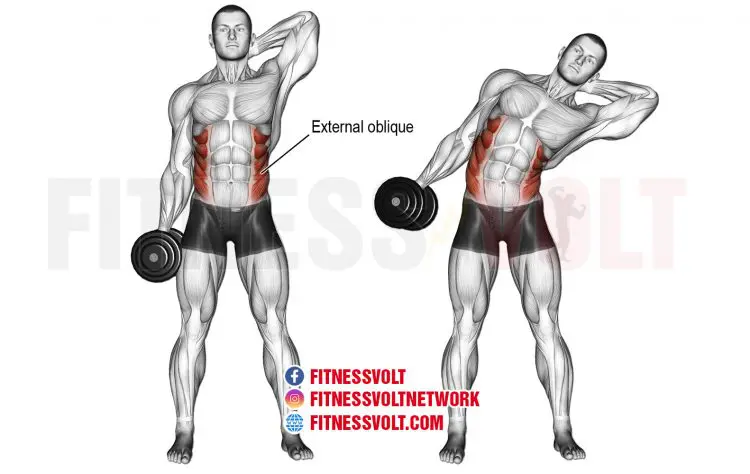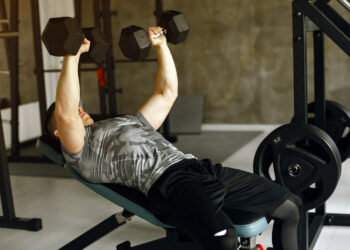The cable side bend is simply a variation of the side bend typically performed using dumbbells. It’s utilized to build the oblique muscles of the core, which gives the midsection a more aesthetic appearance and helps to create the V-taper look.
There has been a misconception that this exercise builds the obliques too big and bulky. However, this is simply not true in most cases. There are many factors to consider when determining the degree of muscular development. But it isn’t likely that the average person will build obliques that are “too big and muscular”.
But you can strengthen these muscles, which has several benefits including increased mobility, injury prevention, improved physical and athletic performance, resilience, and posture support.
Here’s a guide to the cable side bend…
Muscles Worked
The target muscle of this exercise is the oblique muscles.
Obliques
We have internal and external oblique muscles that help us to perform left to right side rotational movements. Located on the outer sides of the rectus abdominis near the lateral trunk, obliques muscles also allow us to crunch to the side or flex laterally toward either direction like you would during side bends.
Level Up Your Fitness: Join our 💪 strong community in Fitness Volt Newsletter. Get daily inspiration, expert-backed workouts, nutrition tips, the latest in strength sports, and the support you need to reach your goals. Subscribe for free!
Rectus abdominis
Together with obliques, the rectus abdominis or superficial ab muscles can flex the torso in a lateral motion. You’ll also get some activation of these core muscles further contributing to their strength and development.
Read: Train Your Obliques For A Killer Core
How To Do The Cable Side Bend
Now it’s time to perform this exercise. But before we give instructions, it’s important to know that is being achieved by performing this exercise. Whichever hand the weight is held in, the opposite side muscle is being targeted. For example, if you hold the handle in your left hand, then the right side gets worked and vice versa.
Here are step-by-step instructions for this exercise…
- Attach a single-grip handle to a low cable pulley.
- Stand sideways to the handle/pulley, bend down and grip the handle, then stand up and take a step or two sideways away from the pulley.
- With feet hip-width apart and chest up with a proper posture, take a breath in, and bend your torso laterally until you feel the muscles contract while exhaling.
- Bend your torso in the opposite direction toward the pulley until you feel a slight stretch in the obliques and repeat.
Here’s a video example…
Cable Side Bend Tips
- You can either place the non-working hand behind your head or hold the same arm by your side so that it slides up and down your leg during the exercise.
- Don’t lean back while performing the side bend. If anything, you want to bend slightly diagonal to maximize the contraction of the obliques, as you would a side crunch.
- There’s no need to bend too far in either direction as this could increase the risk of injury. Although, more experienced exercisers may benefit from using a larger range of motion. Feel a slight stretch during the negatives and bend far enough during the positive until you feel a strong contraction in the obliques.
- Do not use maximal loads with this exercise as this can cause injury, and place a lot of stress on the back and spine. Opt for moderate resistance loads instead.
4 Variations
The cable side bend may offer a few advantages over the dumbbell or free weight variation. Cables provide constant tension in any direction, and your arm isn’t pinned against your body. Therefore, you have a few more angles to work with.
But using free weights is still effective and is many times, the only option. Here are four variations of the side bend.
Dumbbell side bend
Probably the most common variation, the dumbbell side bend has been used for decades to help build impressive obliques. For this exercise, it’s best to use one dumbbell because using two dumbells can offset the resistance on one side, making the movement not as effective.
So, we recommend using one dumbbell and remember, whatever side you’re holding weight will work the muscle of the opposite side.
Level Up Your Fitness: Join our 💪 strong community in Fitness Volt Newsletter. Get daily inspiration, expert-backed workouts, nutrition tips, the latest in strength sports, and the support you need to reach your goals. Subscribe for free!
Cable wood chops
Cable wood chops are an excellent oblique building exercise that has become more popular with exercisers looking to improve the appearance and function of their midsection. We like this exercise because it does so much more than just build muscle and strength, it actually simulates a real-life movement and therefore, will have carryover to functional activities when done properly.
Related: Build a Stronger Core with Shovel Lifts
Hanging windshield wiper
A great bodyweight variation for building those obliques, the hanging windshield wiper is no doubt a more advanced exercise but it’s totally worth it as you’ll develop some Herculean obliques. You’ll need grip strength to hang from the bar, core and hip strength, and mobility and some flexibility to do these.
Weighted Russian twist
A popular variation for hammering the obliques, you might already include the weighted Russian twist in your core routine but if not, then you should. If holding your feet off the ground is too difficult for you at first you can place your feet on the ground or secure them under something.
But if you want more of a challenge, then check out this article on How To Do Russian Twists And Five Exercises That May Be Better.
How To Incorporate The Cable Side Bend Into Your Training Routine
The cable side bend is a great variation to include in your core training because after all, it is a core muscle. And, in our opinion, it’s best incorporated last in your workout.
That’s because we recommend performing exercises from the bottom up. For example, you’ll start with an exercise that uses the heavy load of the legs as resistance (e.g. hanging leg raises, reverse crunch). You’ll then do an exercise that includes both bottom and top movement together such as the recliner crunch, followed by a basic crunch or sit-up. Finally, you’ll end with a standing exercise such as the cable side bend.
You can, of course, include a few more exercises in between as you work up such as a lying rotational exercise but this is a general example of how to get the most from your core training. Structuring your training this way will allow you to maximize your efforts because starting with the most difficult exercise/s first that require the most energy and strength are going to accelerate your strength and development.
Related article: Try This Beastly 30-Day Core Workout To Get Jacked and Strong
Sets/Reps
As for sets and reps, 3 sets x rep range of 8-25 will offer you any benefits that you’d get with this exercise. Of course, you want to vary your reps depending on how much weight you use for that session, but in general, this range will cover all bases.
Plus, you don’t necessarily want to use weight that’s too heavy to where you can’t perform a good eight reps. The same applies to the higher end of the rep range as you won’t benefit much from using too light of weight and performing too many reps. Although you want to take your sets to failure especially when doing higher reps.
Wrapping Up
The cable side bend is good to go for developing the oblique muscles that play an important role in physical movement, injury prevention, posture, and more. We’d even go as far as to say that it’s better than the dumbbell variation that is most common due to the advantages mentioned previously.
But that doesn’t mean you can throw proper form out the window because it’s a movement that still needs to be controlled, focusing on a good stretch and contraction.
We hope you enjoyed this guide and we’re confident you now have the knowledge to execute this exercise safely and effectively.
Interested in measuring your progress? Check out our strength standards for Side Crunch, Russian Twist, Hanging Leg Raise, and more.









